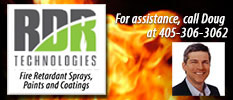Cold Fire Videos
There are several videos that have been shot in Mexico, where Cold Fire is in wide use. It is the exclusive firefighting agent used by PEMEX, the national petroleum organization of Mexico, because it has proven itself over many years to be the most effective fire suppressant in fighting Class B (fuel) fires – for crude, gas, diesel and alcohol-based fires.
In May 2009, RDR Technologies and JRT Environmental did a demo for the Houston Fire Dept at the Val Jahnke Fire Training Center. In this video, we extinguished a tanker holding 165 gallons diesel floating on water in about 40 seconds using just a few gallons of Cold Fire advanced wetting agent.
In May 2009, JRT Environmental and RDR Technologies demonstrated Cold Fire multipurpose foaming wetting agent against four large tires, set in the back of a pickup truck. Diesel was added to the pile as an accelerant. Soon, not only were the tires on fire, but the entire back end of the truck was in flames. Armed only with a 2.5 gallon extinguisher with a quart of Cold Fire added, the fireman put out the tires and the truck bed in just a few seconds.
Below is an excellent demonstration of Cold Fire used against a tank battery fire in Brazil. Most firefighters I’ve talked to will just walk away from a fire like this, and let it burn itself out over several days – at a great cost of both equipment and the environment. Now firefighters have something that will actually work. This was extinguished in just a few minutes with a 3% solution.
Below is a demonstration done in Ecuador, again simulating a tank battery fire. They test against gasoline, diesel, crude and even alcohol (ethanol). Each fire was put out completely in just seconds. Notice the change in color of smoke – at first, huge clouds of black soot, changing to clean white as the hydrocarbons are encapsulated and removed as a fuel source. Also notice in the demo how the men are putting their hands directly on the metal (which should be extremely hot) – demonstrating the instant cooling ability of Cold Fire, which lowers the temperature of whatever it comes in contact with.
This is a another oil tank battery test, where they injecting a 3% solution of Cold Fire directly into the tank through a flow line, decreasing the risk to personnel and firefighters, and actually eliminating the need for a high-pressure fire hose, especially on large tanks. Filmed in Mexico. Listen to the audio at the end of the video, where the inventor of Cold Fire, Jeurgen Giessler, comments how the Cold Fire solution is being fed into the bottom of tank through the flow line.
Cold Fire is extremely effective in neutralizing toxic chemicals (even when they’re not of fire) because of its properties as a hydrocarbon encapsulator. Below is a short clip where the demonstrator drips strong sulfuric acid on a plain cotton towel, then on a cotton towel treated with Cold Fire. Seeing is believing!
This is Part 2 of the sulfuric acid test, where the demonstrator NEUTRALIZES the acid, then actually stirs with his hand. Cold Fire and Carbon Seal can be especially useful in oil and gas applications where various corrosive acids are present in gas or liquid form.
CLass D (metal fires) are some of the toughest fires of all. Spray water on a magnesium fire, and you just make it mad. It burns at 6500 degrees farenheit. A lot of car parts and other engine parts are made from magnesium, so a firefighter never knows what he may be up against in a car fire or garage fire. Here is a demo of putting out a fire of magnesium in just a few seconds.
This was a huge test done with diesel in one 20′ pad, and heptane in the farthest 20′ pad. This flame put out a tremendous amount of heat – you can that the other spectators by the camera couldn’t stand unprotected for more than a few seconds before retreating behind the wall. Again, both pads, even the heptane, were put out in a little over two minutes.
Cold Fire is also used extensively in the restaurant industry. Below is a quick demonstration of Cold Fire against a typical Class K grease fire.
